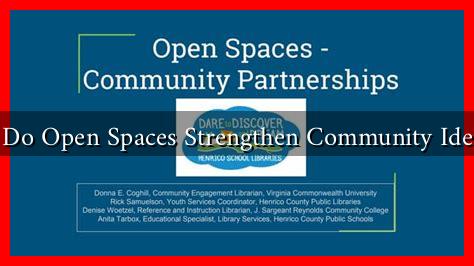-
Table of Contents
- How Do Open Spaces Strengthen Community Identity?
- The Role of Open Spaces in Community Engagement
- Creating a Sense of Place
- Case Studies: Successful Open Spaces and Community Identity
- Statistics Highlighting the Importance of Open Spaces
- Conclusion: The Lasting Impact of Open Spaces on Community Identity
How Do Open Spaces Strengthen Community Identity?
Open spaces, such as parks, gardens, and public squares, play a crucial role in shaping community identity. They serve as gathering places, promote social interaction, and foster a sense of belonging among residents. This article explores how open spaces contribute to community identity, supported by examples, case studies, and relevant statistics.
The Role of Open Spaces in Community Engagement
Open spaces are vital for community engagement, providing a platform for residents to come together and participate in various activities. These spaces encourage social interaction and help build relationships among community members. Here are some ways open spaces facilitate engagement:
- Public Events: Open spaces often host community events such as farmers’ markets, festivals, and concerts, which draw residents together and foster a sense of community.
- Recreational Activities: Parks and open areas provide opportunities for sports, exercise, and leisure activities, promoting a healthy lifestyle and encouraging socialization.
- Volunteer Opportunities: Community gardens and clean-up initiatives in open spaces allow residents to collaborate, enhancing their connection to the area and to each other.
Creating a Sense of Place
Open spaces contribute to the unique character of a community, helping to create a sense of place. This sense of place is essential for community identity, as it reflects the history, culture, and values of the residents. Here are some factors that contribute to this sense of place:
- Historical Significance: Many open spaces are tied to the history of a community, serving as reminders of its past and fostering pride among residents.
- Cultural Expression: Open spaces can showcase local art, architecture, and cultural events, allowing communities to express their identity and heritage.
- Natural Features: The presence of natural elements, such as trees, water bodies, and wildlife, can enhance the aesthetic appeal of a community and create a unique environment.
Case Studies: Successful Open Spaces and Community Identity
Several cities around the world have successfully utilized open spaces to strengthen community identity. Here are a few notable examples:
- Central Park, New York City: Central Park serves as a vital green space for New Yorkers, offering recreational opportunities and hosting numerous cultural events. Its design reflects the city’s diverse population and has become a symbol of New York’s identity.
- The High Line, New York City: This elevated park transformed an abandoned railway into a vibrant public space, fostering community engagement and attracting millions of visitors. The High Line has become a model for urban revitalization and community identity.
- Millennium Park, Chicago: Millennium Park is a prime example of how open spaces can enhance community identity. It features public art installations, performance venues, and green spaces, making it a hub for cultural activities and community gatherings.
Statistics Highlighting the Importance of Open Spaces
Research indicates that open spaces significantly impact community well-being and identity. Here are some compelling statistics:
- A study by the National Recreation and Park Association found that 92% of Americans believe that parks and recreation are essential to their community’s quality of life.
- According to a report by the Trust for Public Land, communities with accessible parks experience lower rates of obesity and improved mental health.
- Research published in the Journal of Urban Design found that well-designed public spaces can increase social interaction by up to 50%.
Conclusion: The Lasting Impact of Open Spaces on Community Identity
Open spaces are more than just physical areas; they are vital components of community identity. By fostering social interaction, creating a sense of place, and enhancing community engagement, open spaces contribute significantly to the overall well-being of residents. As cities continue to grow and evolve, prioritizing the development and maintenance of open spaces will be essential for strengthening community identity and ensuring a vibrant, connected society.
For more information on the importance of open spaces, visit the Trust for Public Land.

